Why wouldn’t you look at low pressure hydraulics first?
We wrote a thoughtful blog on low pressure hydraulics last year and asked the question “why wouldn’t you look at low pressure hydraulics first?”.
The article generated a lot of interest and we have had endless discussion over it. Designers love a chat! Our premise was that designers should think low pressure hydraulics. When designing a one off hydraulic system or a new piece of OEM hydraulic equipment, we thought it was temping to dive straight into 250 bar components and techniques which are just everywhere, in endless catalogues, websites and at all prices. On one offs and even some bigger quantity OEM hydraulics, you might even grab the yellow Enerpac catalogue and move straight to 700 bar working pressure “to sort the design.” Again, the catalogues and “solutions” are there, but at a price. But are you missing a trick? Picking the same medium pressure hydraulic bits as the next guys and spending the same amount of time piping them up isn’t the food of a competitive advantage. Something a little different is what designers need to work on.
“Why would you not step back for a moment and see whether a low pressure hydraulic system could hang together?”
Yes, we think you should visit low pressure, even if it is “not a runner” quite early on. Reluctantly, we would also have to say that you would probably get right up to date and look at electric actuation as well, although that is a future article in itself, as there are some big challenges and opportunities there!
Going right back to hydraulic fundamentals, if Force equals Pressure x Area it is obvious that to achieve a certain force or “tonnage” on a piston rod, you can either go with a low pressure over a large area or a high pressure over a small area. If you are designing or specifying a cylinder, it is immediately obvious that because area has a square in it, a cylinder that will generate twice the force won’t be twice the diameter. A designer will tend to move to higher pressure just to make the cylinder a smaller diameter. Is this always the correct way to go? In moving to higher pressure, your low pressure alloy or composite cylinders will surely turn into carbon steel, simply to cope with the stress, increasing the mass accordingly. There are lots of applications where medium or high pressure is a must, simply to make the cylinder size realistic. All we would say is just work through the figures on day one.
Another basic question is “won’t the power or hand pump be pumping for ever?” Whether you are pumping a large volume to low pressure or a small volume to high pressure, the energy is still the same to do the job. Where you notice the difference straight away is in the space envelope of actuators and the fluid reservoir at a certain size of system. Although the working pressure may be low and cylinders can be attractive alloy or plastic, diameters will be larger, requiring a larger reservoir. This may or may not be a problem.
What are the benefits of running low pressure?
Stay under 50 or 60 bar and we think these are your 5 opportunities to get a competitive advantage:
- Last time we said: “Clever design and production engineering of cylinders, is big, particularly extruded alloy, integrating in extra flow passages, composite barrels and just maybe “something different.”” We have done some clever alloy actuators over the years and we are still waiting for the right application to use Polygon Composites “Polyslide” composite tubing on a low pressure cylinder. Look on polygoncomposites.com.
- Something a bit different on pumps rather than diving straight into gear and piston pumps used on higher pressures. Think solenoids and vending machine technology. We like single shot (as opposed to reciprocating) pumps. These offer opportunities on the right job.
- Using pneumatic and low pressure technology in your valves rather than mainstream medium pressure spool and hard seated designs. There are lots of suppliers of low pressure valves which work incredibly well below the magic 50-60 bar.
- Easy pipe work and connectors, which can be rather useful. Think pneumatics, flexible tubing and Wade or Aignep type fittings.
- Reliability, if sealing is less demanding at low pressure. There are lots of reasons why hydraulics leak, but higher pressures are certainly more troublesome.
There are a surprising number of niche OEM applications where manufacturers have seen the opportunity and that really work rather well. Quite often, you can see that it stacks up on cost compared with trying to do the same thing at higher pressure. There are just so many low pressure designs all around us.
So what are the pointers to successfully using low pressure hydraulics?
If the forces are not enormous and the challenge is to literally make a pneumatic sized system for hydraulic operation, you can have a strong concept. For example, using hard anodised extruded aluminium alloy cylinder section can offer dramatic savings even if your working pressure is limited. As well as the main bore, you might extrude in external features or an additional flow path. If you look at Suspa worktop levelling systems, they cleverly integrate four single shot hydraulic pumps into one alloy pump assembly with all four piston rods running off a single crank to keep each ram in sync. Their cylinders are manufactured from alloy. There is a certain elegance in this design. We know from the likes of SMC how slick hard anodised alloy cylinders based on extrusions can be.
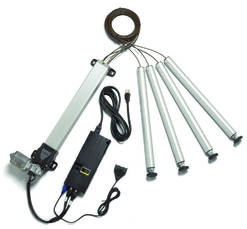
Suspa levelling system – four cylinders operated by a single leadscrew.
Just keep in mind some advantages in low loads on pump piston rods. Suspa are running their four rods from a pump operated by a single leadscrew, something that is probably much more difficult at higher pressures. They have achieved a “single shot” pump which always seems to us to be attractive compared with reciprocating piston pumps and gear pumps. Of course your biggest applications of single shot pumps and multiple actuators are automotive braking systems. Even a clutch master cylinder and slave has offered a very resilient solution to an engineering problem for decades.
If conventional hydraulic hoses with swivels are the hassle in higher pressure systems, stepping back and piping a system up in small bore nylon tubing is a decisive thing to do. Where runs are tortuous, radii tight, tubes need to be threaded through small holes or costs need to be addressed, nylon can offer benefits. Remember that you can source high pressure nylon tube and that Wade type fittings will provide very low tech connections. Whether it is the Suspa levelling system or Bennett powerboat trim tabs, being able to use nylon pipe work seems to be an important angle.
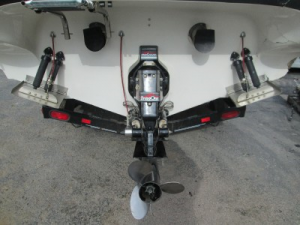
Bennett trim tabs achieve long service life in salt water – a great example of low pressure hydraulics and good engineering reducing maintenance demands.
Whilst reflecting upon innovative cylinder design for lower pressure hydraulics, the Bennett marine trim tab uses a moulded plastic cylinder barrel with the pivot as a flexure in the same moulding. In this equipment, the whole job is very inexpensive and because loads are relatively low, Bennett has engineered a clever low pressure hydraulic system. They have been selling large quantities for years.
Can I design low pressure actuators with no dynamic seals?
Could you see wide application of low pressure actuators with no dynamic seals in them at all? You can make an actuator with a diaphragm, a convoluted bellows or a rolling bellows at a price. Never the less, you have removed the dynamic seal and at low pressure, these work. You can fabricate metallic bellows rather than using moulded elastomeric convoluted bellows on your low pressure actuator. We were interested to see Senior Engineering supplying convoluted metallic bellows from their Bird Bellows company in ultra low maintenance aerospace accumulators for a Cessna executive jet. Yes, fabricated metallic bellows will be expensive but do open the mind to whether for future zero leakage actuators we might find that advanced manufacturing could provide clever and cheap bellows or diaphragms that make low pressure systems a winner.
If you are into an OEM product integrating a ram and pump, keep in mind the BFT electro-hydraulic door and gate opener as an example of how slick and inexpensive this can be. Again, the low pressure route has worked for this Italian design for years. We wonder whether for them the ability to open up a needle valve to decouple the hydraulics and allow the doors to be used by hand was a big plus over an electric system. 20 years on, would they have designed all-electric today? Who knows?
Even for larger volumes, low pressure hydraulics can work really well, for example as in the Rotork Skilmatic actuator. Here an integrated low pressure pump and optional manual over ride pump provides a very highly respected valve actuator. Low pressure actuation is still a big business.
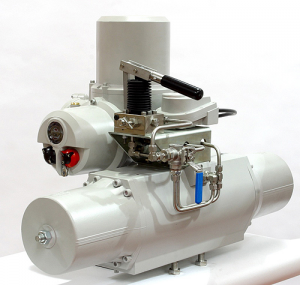
A Rotork Skilmatic actuator.
Does low pressure make a system more dependable?
I suppose instinctively you would say yes. Seals must be subject to much lower stress than high pressure systems. Seals are not going to extrude at low pressures. If there is a failure, the leak will probably be less spectacular, although a leak is still a leak. These low pressure systems we are discussing still need to be high quality design and manufacture.
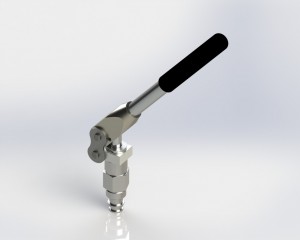
Micropac MT cartridge pump with short handle.
What about our own equipment for low pressures?
Micropac hydraulics works as well on 7 bar as 700 bar. Look at our MT cartridge units or MW pumps. We offer knob actuated cartridge pumps that provide an inexpensive and easy fix for lower pressures and a small space envelope. Who uses them? Manual over rides for all manner of low pressure systems are the biggest user. Hydraulic passenger door openers on coaches, various braking systems and marine applications can use this sort of pump with success.
Sarum Hydraulics are the Micropac hydraulic hand pump experts. High pressure, low pressure, low corrosion and tricky fluids. We know our hand pumps. See what we do on www.sarum-hydraulics.co.uk.


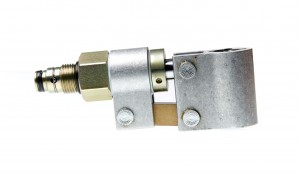



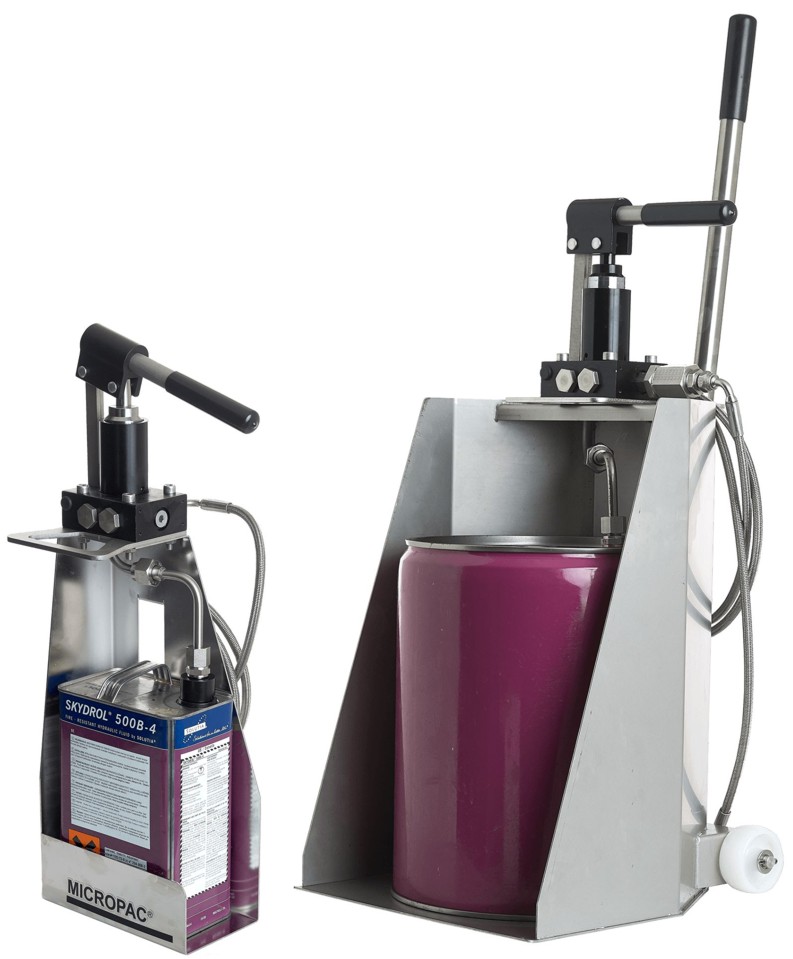
Nice post, very informative.Thanks for sharing these blogs with us!